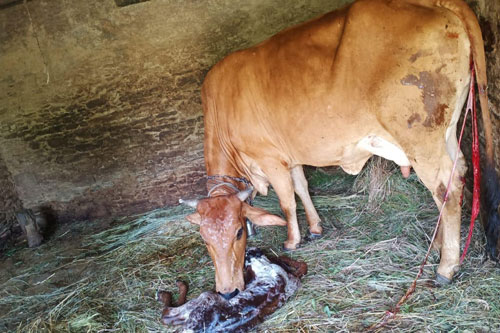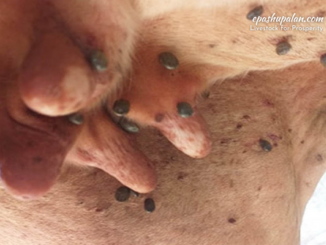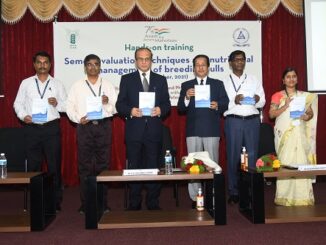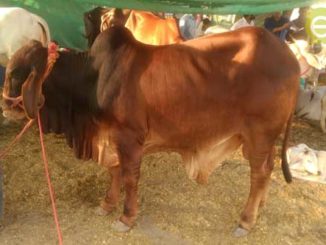1. Bruises, lacerations and rupture of birth canal
Etiology
- Calving difficulties/ dystocia.
- Rough handling of the calf .
- Rough handling of the maternal tissues.
- Careless use of obstetrical instruments.
- Non lubricated and dry birth canal leads to injuries.
Treatment
- Corticosteroids to reduce swelling and assist in nerve healing.
- Downers should be hoisted 15-20 minutes twice a day.
- ‘Slipouts’ able to stand should be in a clean dry pen with hobbles.
- Vitamin E/ Selinium for supportive therapy
- Nervine tonic must be administered.

2. Uterine Prolapse
Eversion /expulsion of the uterus through the vulva to the outside of the body. It occurs immediately after parturition/ or occasionally up to several hours or days afterwards.
Etiology
- Dystocia with injury /irritation of the external birth canal followed by severe straining.
- Hypocalcemia, Violent tenesmus, Inadequate exercise.
- Retained fetal membranes especially at the tubal end of gravid horn.
- Excessive relaxation of the pelvic and perineal regions.
- Vigourous forced traction applied during extraction of fetus.
- Loose uterine attachment in the abdominal cavity.
- Relaxed, flaccid and atonic uterus.
- Poor uterine tone post-partum due to mineral deficiency/ insufficiency.
- Poor body condition with malnutrition.
Treatment
- Prolapsed uterus to be kept clean and moist using 1:10,000 KMnO4 solution.
- Reduce uterine edema using sulfa-urea, sugar, ice etc.
- Admisteration of caudal epidural anesthesia (5-8 ml Xylocaine 2% solution containing 2% Lignocaine Hcl ) prior to replacement and reposition of prolapsed mass.
- Repair any tearing by use of an absorbable suture( chromic catgut).
- Prolapsed mass should be raised dorsally to reduce the obstruction in urethra (sharp kink), resulting in to removal of urine which facilitates in the reduction of the size of urinary bladder and thus prolapsed mass can easily be replaced or if by this method bladder is not reduced in size , remove the urine by using urinary catheter or aspirate the urine with the help of fine needle.
- Replace the uterus little by little first with those portions nearest to the vulvar lips.
- First the ventral portions and then the dorsal portions of the prolapsed mass should be replaced.
- During replacement of uterus, pressure should be exerted with the help of palm and extended fingers, to avoid injury to the uterus because if accidentally caruncles get ruptured, profuse bleeding may occur.
- As the prolapsed mass comes inside the vulvar lips, use fist to press the prolapsed mass through the cervix to the full length of arm until the gravid horn becomes straight and no invagination remains left.
- Evert both the horns fully, to prevent straining and recurrence of the prolapse.
- Suture the vulva, leaving1/3 ventral part for urination closed for 3-5 days.
- If the animal continues straining following replacement of of the uterus, it may be due to invagination of the tubal end of the uterine horn or an irritation or inflammation of the vulva. The invagination can be corrected by inserting the clenched fist again. The irritation can be abolished by applying the Xylocaine jelly (2% Lignocaine Hcl jelly) on the vulva.
Post- replacement therapy and care
- Give parentral antibiotics like Oxytetracylin for 5-7 days.
- Intrauterine antibiotics/ antimicrobials for 3-5 days.
- Non-steroidal anti-inflammatory drugs (NSAIDs) and Antihistaminics.
- Vitamin B-complex inj. for 3-5 days I/M.
- Tranquilizers like sequil -5 ml, I/M
- Application of Xylocaine jelly on the vaginal wall 2 to 3 times for 3-5 days.
- Calcium and phosphorus preparations.
- Give oxytocin to hasten involution of uterus and check hemorrhage.
- Good nursing, laxative diet, and moderate exercise.
- Rear portion of the animal should be raised.
3. Obturator paralysis
Etiology
- Excessive force of traction to deliver a calf.
- Poor footing slip and ‘slip out’.
- Pelvic damage leads to downer cow.
- Injury to obturator nerve leads to its paralysis.
Treatment
- Corticosteroids to reduce swelling and assist in nerve healing.
- Downers should be hoisted 15-20 minutes twice a day.
- ‘Slip outs’ able to stand should be in a clean dry pen with hobbles.
- Vitamin E/ Selinium for supportive therapy.
- Nervine tonic must be administered
4. Retained placenta
- ROP or RFM may occur if the placenta has not been expelled by 08 to 12 hrs after calving.
- After abnormal delivery (e.g. Foetotomy, Forced extraction of fetus, abortion, premature calving, caesarian section, twin pregnancy) and in herds infected with brucellosis its incidence rate can range between 20 to 50% or even more.
- As ROP predisposes the development of uterine infections (Puerperal metritis, clinical and sub-clinical metritis) decrease in milk production and reproductive performance (increases in days open, services per conception, calving to first heat interval, days from calving to first service and culling rate).
Etiology
- Mechanical / physical causes: dystocia, fetotomy, caesarean section, twinning or abortion, uterine torsion.
- Infectious causes: Brucellosis, Listeriosis, Leptospirosis and IBR.
- Nutritional causes: Low β- carotene, Vitamin A and VitaminE
Diagnosis
If the placenta has not been shed by 12 to 24 hrs after calving. Some times part of fetal membrane hanging from the vulva.
Treatment
- Manual traction; gentle, slight without excessive pulling.
- Pack the uterus with intrauterine antibiotic/antimicrobials boluses.
- Good hygiene to prevent secondary complications.
- Systemic antibiotics should be given if uterus develops infection.
- Oxytocin is useful within first 48 hrs to reduce the uterine size and may help in reduction of uterine size and placental release.
- Manual removal of RFM is a common veterinary practice despite the various studies shows its deleterious effect on the post partum uterus. Higher frequency of isolation of uterine pathogens, suppression of uterine leucocytic phagocytosis, and higher percentage of subsequent endometritis are the main side effect of manual removal of placenta in bovines.
- Intrauterine application of antibiotics (ampicillin+ cloxacillin, chlortetracycline, tetracycline) in cows with RFM did not improve the reproductive performance or milk yield compared to non-treated RFM cows.
- Recent studies indicates that administration of ceftiofer (1mg/kg) to RFM cows only in case of fever during 10 days postpartum was as effective as, in form of reproductive performance, manual removal of placenta and or/intrauterine antibiotic and systemic administration of ceftiofar to RFM cows at days 1 after calving.
- Hence unnecessary antibiotic usage can be avoided by only treating febrile cows with RFM.
- Treatment with oxytocin, PGF2α, or calcium was not much effective for the prevention of RFM or did not hasten the passage of fetal membranes.
| The content of the articles are accurate and true to the best of the author’s knowledge. It is not meant to substitute for diagnosis, prognosis, treatment, prescription, or formal and individualized advice from a veterinary medical professional. Animals exhibiting signs and symptoms of distress should be seen by a veterinarian immediately. |






Be the first to comment